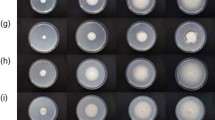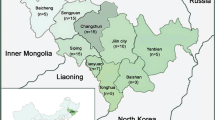Abstract
Saprolegnia diclina andS. parasitica isolated from three sources could germinate in strong acidic conditions. Growth ability correlated with the species of fungi rather than with the sources from which they were isolated.S.diclina isolates appeared to germinate at a pH condition as low as 3.5, whereasS. parasitica isolates could not germinate at below pH 3.8.S. parasitica isolates from visceral mycoses still showed good growth at 30°C, whereas other isolates did not. Also,S. parasitica isolates from visceral mycoses produced more abundant motile zoospores, and continued to do so for a longer period of time (28 d), thanS. parasitica isolates from external saprolegniasis andS. diclina isolates.
Similar content being viewed by others
Literature cited
Beakes, G. W. 1983. A comparative account of cyst coat ontogeny in saprophytic and fish lesion (pathogenic) isolates of theSaprolegnia diclina-parasitica complex. Can. J. Bot.61: 603–605.
Bly, J. E., Lawson, L. A., Szalai, A. J. and Clem, L. W. 1993. Environmental factors affecting outbreaks of winter saprolegniasis in channel catfish,Ictalurus punctatus (Rafinesque). J. Fish Dis.16: 541–549.
Bruno, D. W. and Stamps, D. J. 1987. Saprolegniasis of Atlantic salmon,Salmo salar L, fry. J. Fish Dis.10: 513–517.
Dieguez-Uribeondo, J. 1995. Adaptation to parasitism of some animal pathogenic Saprolegniaceae. Comprehensive Summaries of Uppsala Dissertations from the Faculty of Science and Technology 122 Acta Universitatis Upsalienis. Uppsala.
Hatai, K. and Egusa, S. 1977. Studies on visceral mycosis of salmonid fry-II. Characteristics of fungi isolated from the abdominal cavity of amago salmon fry. Fish Pathol.11: 187–193.
Hatai, K., Willoughby, L. G. and Beakes, G. W. 1990. Some characteristics ofSaprolegnia obtained from fish hatcheries in Japan. Mycol. Res.94: 182–190.
Kitancharoen, N., Yuasa, K. and Hatai, K. 1995. Morphological aspects ofSaprolegnia diclina Type 1 isolated from pejerrey,Odonthetes bonariensis. Mycoscience36: 365–368.
Nolan, R. A. 1975. Physiological studies with the fungusSaprolegnia megasperma. Can. J. Bot.53: 2110–2114.
Nolan, R. A. 1976. Physiological studies on an isolate ofSaprolegnia ferax from the larval gut of the blackflySimulium vittatum. Mycologia68: 523–540.
Olah, J. and Farkas, J. 1978. Effect of temperature, pH, antibiotics, formalin and malachite green on the growth and survival ofSaprolegnia andAchlya parasitic on fish. Aquaculture13: 273–288.
Peduzzi, R., Kappeli, F. and Turian, G. 1991. Repercussion de l'acidification de l'eau sur l'insurgence de la saprolegniose chez le poisson. Sonderdrucke aus Sydowia43: 135–147.
Pickering, A. D., Willoughby, L. G. and McGrory, N. R. 1979. Fine structure of secondary zoospore cyst cases ofSaprolegnia isolates from infected fish. Trans. Br. Mycol. Soc.72: 427–436.
Schaefer, W. F., Heckmann, R. A. and Swenson, W. A. 1981. Post spawning mortality of rainbow smelt in western Lake Superior. J. Great Lake Res.7: 37–41.
Turian, G., Kappeli, F. and Peduzzi, R. 1991. Acidification apicale des tubes germinatifs du champignon aquatiqueSaprolegnia parasitica correlee avec la mycose de poissons soumis au stress acide. Bot. Helv.101: 267–271.
Wada, S., Hatai, K. and Ishii, H. 1993. Mycotic gastritis of juvenile ayu (Plecoglossus altivelis) caused bySaprolegnia diclina Type 1. J. Wildlife Dis.29: 587–590.
Willoughby, L. G. 1978. Saprolegnias of salmonid fish in Windermere: a critical analysis. J. Fish Dis.1: 51–67.
Willoughby, L. G. and Roberts, R. J. 1992. Towards a strategic use of fungicides againstSaprolegnia parasitica in salmonid fish hatcheries. J. Fish Dis.15: 1–13.
Yuasa, K. 1995. Studies on taxonomy of pathogenic fungi from fishes with saprolegniasis Tokyo: Nippon Veterinary and Animal Science University. PhD. Thesis.
Yuasa, K. and Hatai, K. 1995. Relationship between pathogenicity ofSaprolegnia spp. isolates to rainbow trout and their biological characteristics. Fish Pathol.30: 101–106.
Author information
Authors and Affiliations
About this article
Cite this article
Kitancharoen, N., Yuasa, K. & Hatai, K. Effects of pH and temperature on growth ofSaprolegnia diclina andS. parasitica isolated from various sources. Mycoscience 37, 385–390 (1996). https://doi.org/10.1007/BF02460994
Accepted:
Issue Date:
DOI: https://doi.org/10.1007/BF02460994




